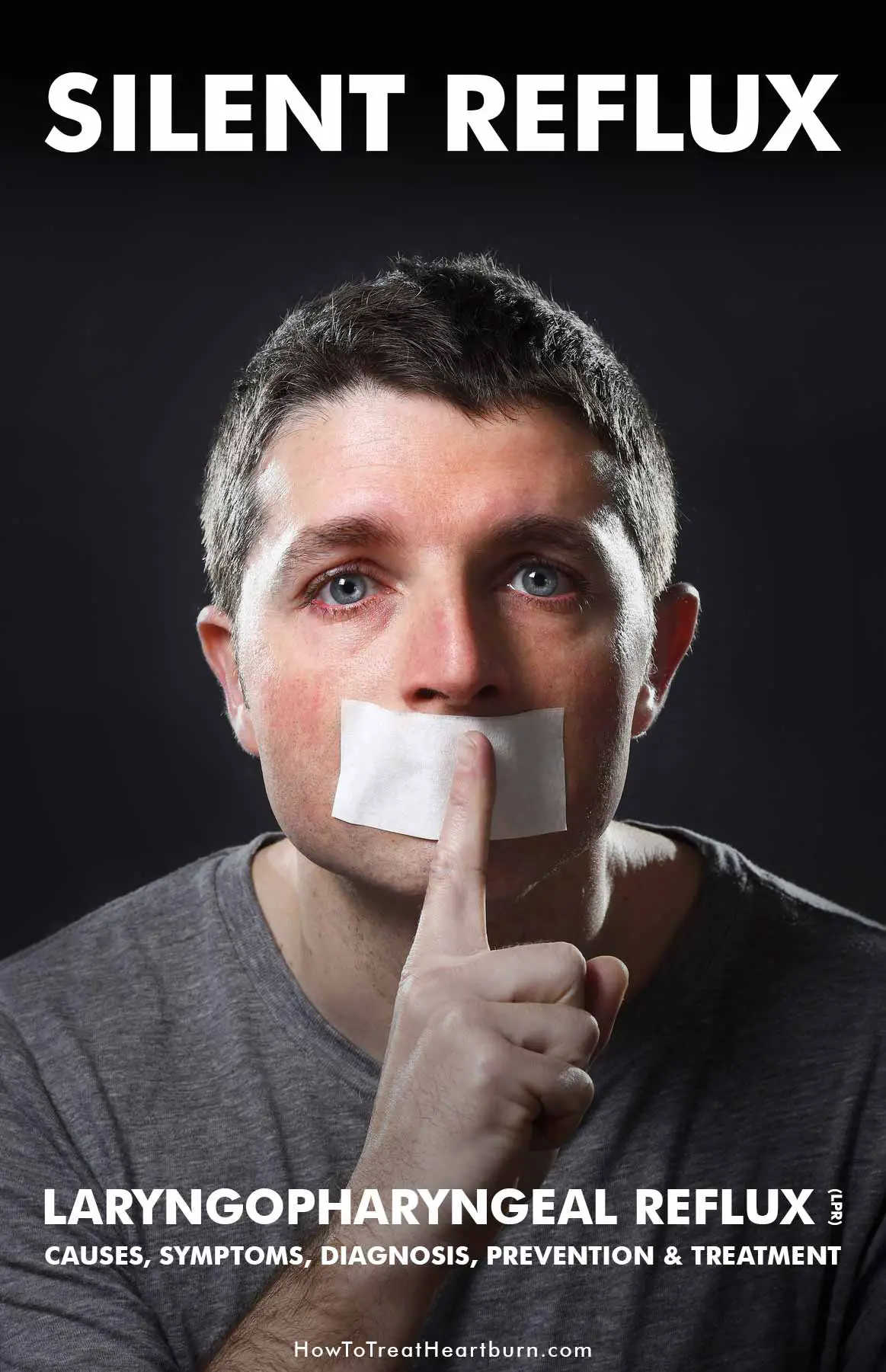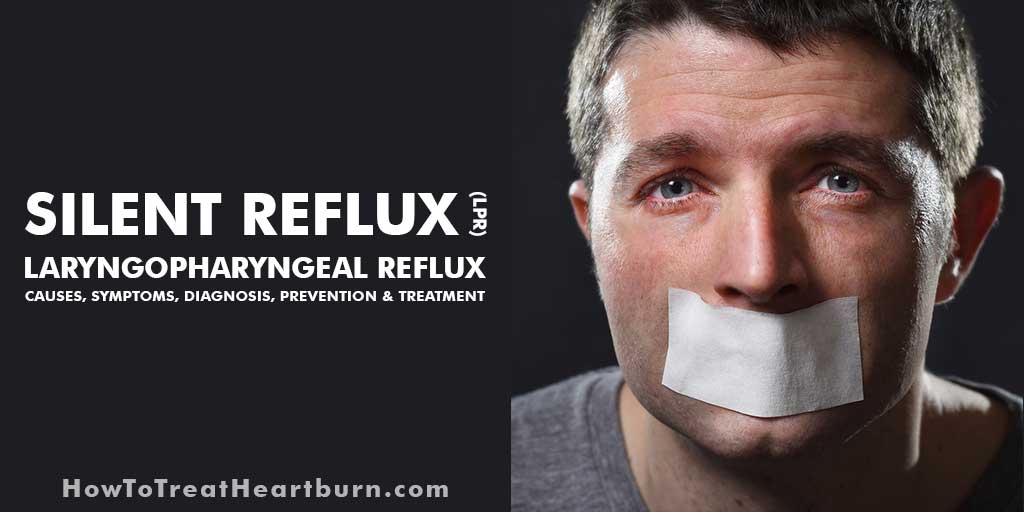Disclosure: I am compensated for purchases made through some links on this site. Click for details.
Laryngopharyngeal reflux (LPR), also known as silent reflux, is the reflux of stomach contents into the larynx (voice box) and pharynx (throat). Stomach acid can not only reflux beyond the esophagus into the throat and voice box but also into the lungs, mouth, sinuses, ears, and nose.1
Many people experiencing silent reflux do not experience heartburn symptoms found in GERD because refluxed acid does not remain in the esophagus long enough to cause heartburn irritation. Silent reflux is different from GERD as it primarily affects a different area of the body.
Silent Reflux Causes
At the upper and lower ends of the esophagus are rings of muscle known as sphincters. They act as valves that open to let swallowed food pass and close behind it to keep food and stomach contents where they belong.
The lower sphincter is the lower esophageal sphincter (LES). Reflux occurs when stomach contents leak back through the LES into the esophagus.
The upper sphincter is the upper esophageal sphincter (UES). Refluxed stomach contents can leak through this sphincter as well, allowing acid to come in contact with the throat, vocal cords, lungs, mouth, sinuses, ears, and nose.
The closure of the LES and UES can be compromised by a hiatal hernia or pressure on the sphincter. The closure can also be weakened by certain food, drink, or medication.
Infants may experience silent reflux when their LES and UES muscles aren’t fully developed. Infants also spend a great deal of time lying down which causes food pressure on the sphincters.
Lifestyle and diet choices are the main causes of acid reflux in adults. These can cause pressure on the esophageal sphincters, weakening of the sphincters, and/or excess stomach acid.
These lifestyle and diet choices include:
- Overeating
- Being overweight
- Eating unhealthy foods
- Eating processed foods
- Eating heartburn trigger foods
- Eating to close to bedtime
- Eating foods in the wrong order
- Eating too quickly
LPR Symptoms
Silent reflux symptoms in adults may include:2
- Hoarseness
- Chronic cough
- Sore throat
- Hiccups
- Lump in the throat feeling
- Difficulty swallowing
- Excess throat mucus
- Excessive throat clearing
- Nasal drainage
- Bitter/sour taste
- Bad breath
- Tooth decay
- Loss of smell
- Ear infections
- Hearing problems
- Trouble breathing
- Pulmonary aspiration
- Asthma
- Snoring
- Sleep apnea
- Laryngeal nodules in singers
Silent reflux symptoms in infants may include:2
- Hoarseness
- Chronic cough
- Breathing issues
- Croup
- Asthma
- Sleep apnea
- Feeding issues
- Spitting up
- Pulmonary aspiration
- Trouble gaining weight
Silent Reflux Diagnosis
An otolaryngologist or laryngologist is typically the type of doctor to visit for diagnosing and treating silent reflux. Where a gastroenterologist is more likely to diagnose and treat those with GERD.
Otolaryngology covers the treatment of the ears, nose, and throat and Laryngology focuses on the treatment of the larynx. Doctors practicing in these disciplines are more commonly referred to as ear, nose, and throat doctors or ENT doctors.
Though difficult to diagnose due to its variety of symptoms, a doctor can diagnose silent reflux by studying the patient’s medical history, through a physical exam, and testing.
Medical tests may include one or more of the following to evaluate and treat silent reflux.3,4
- Barium Swallow: Liquid barium is swallowed and x-rays are taken in this test to see if there are any abnormalities in or damage to the esophagus and stomach.
- Endoscopy: In an endoscopy, the doctor runs a flexible tube with a camera down the esophagus to look for issues in the esophagus and stomach.
- Biopsy: During an endoscopy, tissue samples can be taken and checked for complications such as cancer.
- pH Monitoring: A device is inserted into the esophagus and left for 1-2 days to measure acid levels.
- Esophageal Manometry: In this test, a narrow, pressure-sensitive tube is run through the nose and down the esophagus to test the function of the esophageal muscles and sphincters.
Silent reflux along with all other reflux issues in infants and children should be diagnosed and treated by a doctor.
Silent Reflux Complications
Silent reflux complications in adults may cause:2,5
- Increased risk of cancer in the esophagus, throat, voice box, and lungs
- Acid erosion and scaring in the throat and larynx
- Ulcers
- Formation of a stricture
- Choking
- Aspiration which may lead to pneumonia
- Problems with the lungs including asthma, emphysema, and bronchitis
Silent reflux complications in infants may cause:
- Stricture or narrowing below the larynx
- Formation of ulcers
- Ear infections
- Fluid buildup in the middle ear
Silent Reflux Prevention
Diet and lifestyle changes are often effective in eliminating silent reflux. These changes should be adopted for the long term as symptoms will likely return if old diet and lifestyle habits resume. These changes for adults include:6
- Avoiding pressure on the esophageal sphincters. Pressure can cause stomach contents to reflux through the sphincter. Pressure may be caused by:
- Being overweight
- Certain exercise movements
- Overeating… Eating smaller meals 4-5 times a day is better that 2-3 larger meals.
- Reclining after eating
- Avoiding heartburn trigger foods
- Avoiding tight clothing around the abdomen/waist
- Stopping use of nicotine products
- Avoiding alcohol
- Losing weight if overweight
- Fasting 2-3 hours before bedtime
- Raising the head of the bed 6-8 inches with blocks or torso with use of a mattress bed wedge or acid reflux pillow system
- Adopting a low-fat, high-fiber diet
- Avoiding processed foods
- Having your doctor review your medications for any that may cause your esophageal sphincters to relax. Certain medications can cause the esophageal sphincters to relax. Different medications or the time when you take medications may help avoid reflux.
- Treating or having any structural abnormalities like a hiatal hernia repaired.
Silent reflux treatment for infants may include:
- Smaller, more frequent feedings
- Keeping the infant upright for 30 plus minutes after feeding
- Administering prescribed acid reflux medications as directed by a physician
- Surgery if it’s required to repair any structural abnormalities
Related Content:
Silent Reflux Treatment
For adults, acid reflux medications may be prescribed if diet and lifestyle changes alone are not enough to prevent silent reflux. If medications fail, surgical options exist for correcting the stomach valve and preventing acid reflux.
Silent reflux treatments for infants may include acid reflux medications as prescribed by a doctor or surgery to repair structural abnormalities if any exist.
Acid Reflux Medications
Acid reflux medications should be discussed with your doctor before treating your symptoms. These medications primarily mask the symptom of heartburn.
Diet and lifestyle changes are typically required to remedy acid reflux problems. We are all different and respond differently to treatment options.
Your doctor will guide you through your best silent reflux treatment.2,7
Heartburn medications are considered to have three levels of aggression. They are antacids, H2 blockers, and PPIs.
1. Antacids
Antacids are fast-acting acid-neutralizing medications that can provide relief for up to two hours. Some antacids provide a coating as well as a neutralizer to help protect by forming a barrier against acid.
Antacids include:
- Tums
- Rolaids
- Rennie
- Alka-Seltzer
- Gaviscon
- Pepto-Bismol
- Kaopectate
- Maalox
- Mylanta
- Phillips’ Milk of Magnesia
2. H2 Blockers
H2 blockers take a few hours to act and provide up to twelve hours of relief by reducing stomach acid production.
H2 blockers include:
- Zantac
- Pepcid
- Tagamet
- Axid
3. Proton Pump Inhibitors (PPIs)
PPIs are the strongest acid suppressants available. Their primary use is to lower stomach acid for the healing of acid-damaged tissue.
PPIs are typically used for short periods as directed on the pharmaceutical label or prescribed by your doctor.
PPIs are linked to an increased risk of heart attack, chronic kidney disease, liver damage, increased risk of death, and much more. PPIs also cause a rebound in acid production upon discontinuation of use.
PPIs include:
- Prilosec
- Prevacid
- Nexium
- Zegerid
- AcipHex
- Dexilant
- Kapidex
- Losec
- Protonix
- Rapinex
- Vimovo
Surgery for Silent Reflux
Two of the surgical options to improve the function of an esophageal sphincter are implantation of the LINX device and fundoplication.
LINX Device: The LINX device consists of a ring of titanium beads on a titanium wire. The LINX device is surgically implanted around the esophagus to mechanically strengthen the sphincter.8
Fundoplication: Fundoplication takes the top part of the stomach and wraps it around the LES to strengthen it.

References
1) “Grabscheid Voice and Swallowing Center of Mount Sinai.” New York Eye and Ear Infirmary of Mount Sinai (NYEE), (n.d.).
2) Dr. VyVy Young. “GERD and LPR.” American Academy of Otolaryngology–Head and Neck Surgery Foundation, (n.d.).
3) “Diagnosis of GER & GERD.” The National Institute of Diabetes and Digestive and Kidney Diseases Health Information Center, November 2014.
4) Charles N. Ford, MD. “Evaluation and Management of Laryngopharyngeal Reflux.” JAMA Network, September 28, 2005.
5) Vanita Ahuja, M.D., Myron W Yencha, M.D., & Lorenz F Lassen, M.D. “Head and Neck Manifestations of Gastroesophageal Reflux Disease.” American Academy of Family Physicians., September 1, 1999.
6) Irene Martinucci, Nicola de Bortoli, Edoardo Savarino, Andrea Nacci, Salvatore Osvaldo Romeo, Massimo Bellini, Vincenzo Savarino, Bruno Fattori, & Santino Marchi. “Optimal treatment of laryngopharyngeal reflux disease.” National Center for Biotechnology Information, U.S. National Library of Medicine, Therapeutic Advances in Chronic Disease: SAGE Journals, November 2013.
7) “Laryngopharyngeal Reflux (LPR).” The Ohio State University Comprehensive Cancer Center, July 23, 2018.
8) Luigi Bonavina, Greta Saino, John C. Lipham, & Tom R. DeMeester. “LINX® Reflux Management System in chronic gastroesophageal reflux: a novel effective technology for restoring the natural barrier to reflux.” National Center for Biotechnology Information, U.S. National Library of Medicine, Therapeutic Advances in Gastroenterology, July 2013.




I have been taking omeprazole since last May for silent acid reflux. Has anyone complained of bladder infections from Omeprazole and constant itching?
I am taking 40 mg of Omeprazole dr 40 mg in the morning and Ranitidine 150 mg twice a day with no relief for my silent reflux. It is not working. I also can’t find a list of foods that I can eat online
Hello Heather! Please discuss your lack of relief with your doctor they need to be aware in order to treat you properly. Also, bring up the new study published in the JAMA Otolaryngology where the Mediterranean diet and drinking alkaline water is found just as effective in treating laryngopharyngeal reflux as PPIs. The Mediterranean diet might be your answer to treatment and foods you can eat.
I’m on the acid reflux diet I found it on Pinterest and it’s helping but if I cheat I lose my voice and/or stomach problems. I only eat chicken, turkey and seafood. Once a month I’ll eat a few bites of lean beef or pork. Any vegetable but tomatoes and onions and anything made with them, I leave out all caffeine, decaf, alcohol, dairy, citrus fruits, eggs, and process foods, and cream based soups or sauces. For snack I eat almonds, pretzels, plain crackers and bread. I eat granola cereal with unsweetened almond milk. It’s not easy but I know immediately if I stray from it. I’ve lost weight and feeling better, too.